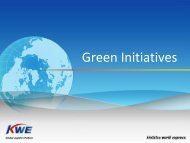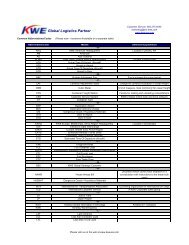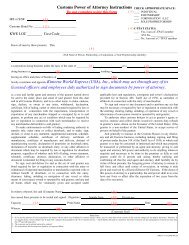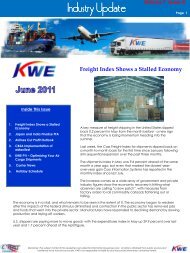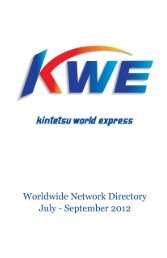KWE Industry Update - Kintetsu World Express (USA), Inc.
KWE Industry Update - Kintetsu World Express (USA), Inc.
KWE Industry Update - Kintetsu World Express (USA), Inc.
You also want an ePaper? Increase the reach of your titles
YUMPU automatically turns print PDFs into web optimized ePapers that Google loves.
Page 4<br />
Cargo Screening Deadline Pushed Up<br />
The Transportation Security Administration (TSA) has announced an<br />
accelerated deadline of Dec 31, 2011 for 100% cargo screening on all<br />
inbound U.S. international passenger flight.<br />
Last summer, TSA, testified before Congress that it would take until 2013<br />
before an all-cargo screening policy on international passenger aircraft<br />
could be effectively put into place. However, in an e-mail to freight<br />
forwarders and shippers, the organization pointed to “recent global<br />
events” as justification for pushing the deadline up by a full two years.<br />
This announcement will have an immediate effect on the air cargo industry beyond just the increased cost of<br />
screening more packages since it will require earlier cut-offs for cargo, reducing some of the expedited<br />
advantage of airfreight. The mandate could possibly provide further advantage to large forwarders and<br />
integrators over mid-size and small forwarders, and it may have more shippers considering ocean cargo as an<br />
alternative.<br />
Though December is nearly a full year away, that still doesn‟t leave a lot of time for the myriad changes that<br />
need to be made before screening can be implemented. One of the largest hurdles will be coordinating<br />
security measures in origin countries, which involves making sure the TSA, airlines and each country are on the<br />
same page.<br />
Many feel that the TSA requirement just may not be feasible. A percentage based on origin can be achieved<br />
by December, but not 100%– we‟re more likely looking within the 75% range. This is an important part of cargo<br />
and national security, but the TSA will have to move much faster than they have in the past with establishing<br />
rules and guidelines if they want to achieve 100 percent by this deadline.<br />
Hong Kong & New Zealand<br />
Eliminating Tariffs<br />
The New Zealand-Hong Kong, China Closer Economic<br />
Partnership Agreement (the “CEP”) was signed in Hong Kong<br />
on March 29, 2010 and entered into effect on January 1, 2011.<br />
Hong Kong is New Zealand‟s 9th largest export destination and<br />
the total bilateral merchandise trade between the two<br />
countries amounted to about HK$6.5 billion ($837 million) in<br />
the first nine months of 2010, with average annual growth rate<br />
of 2.7% from 2005 to 2009.<br />
Based on the average merchandise trade figures in recent<br />
years, Hong Kong's annual tariff saving is estimated to be<br />
about HK$7 million (USD$900,900), according to the figures<br />
earlier released on the Hong Kong government's website.<br />
Under the Closer Economic Partnership Agreement (CEP) signed in March, New Zealand will phase out its import<br />
tariffs on all goods originating in Hong Kong and all of Hong Kong‟s exports to New Zealand will be tariff-free within<br />
six years. More than 90% of New Zealand‟s tariff lines will become duty free within two years. Hong Kong has<br />
committed to cut all tariffs on products from New Zealand and remove 64% of export tariffs immediately after the<br />
CEP Agreement begins. This will cover certain electrical machinery and equipment, sound recording and<br />
reproducing apparatus and wooden items. The agreement also covers the six industries in which Hong Kong<br />
specializes and is promoting further development, namely education services, medical services, testing and<br />
certification services, environmental services, innovation and technology, and cultural and creative industries.<br />
This deal will help New Zealand businesses boost trade with Hong Kong and take further advantage of growing<br />
opportunities in the region. The CEP also complements New Zealand‟s Free Trade Agreement (FTA) with China and<br />
enhances the potential for Hong Kong to be used as a platform for trade into Mainland China.<br />
It contains measures to improve business flows and promote cooperation in a broad range of economic areas of<br />
mutual interest, and is supported by legally-binding side agreements on Labor and Environment that are in line with<br />
New Zealand‟s broader objectives for sustainable development. A legally-binding side agreement was also<br />
secured to negotiate an Investment Protocol within two years of entry into force.<br />
Disclaimer: The subject matter of this newsletter is provided for informational purposes only. All data is obtained from public sources and is<br />
believed to be true and accurate. <strong>KWE</strong> is not responsible or liable for any inaccurate information contained herein.



